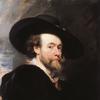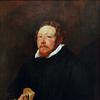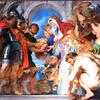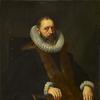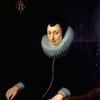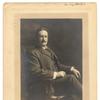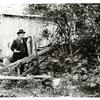
安吉亚里之战(列奥纳多·达芬奇之后的复制品)
The Battle of Anghiari (copy after leonardo da Vinci)
作品:安吉亚里之战(列奥纳多·达芬奇之后的复制品)
英文:The Battle of Anghiari (copy after leonardo da Vinci)
类型:绘画
尺寸:54.2cm × 63.7cm
日期:
收藏:卢浮宫,法国
标签:
The Battle of Anghiari (1505) is a lost painting by Leonardo da Vinci, often referred to as "The Lost Leonardo", which some commentators believe to be still hidden beneath one of the later frescoes in the Salone dei Cinquecento (Hall of the Five Hundred) in the Palazzo Vecchio, Florence. Its central scene depicted four men riding raging war horses engaged in a battle for possession of a standard, at the Battle of Anghiari in 1440.
《安吉亚里之战》(1505)是列奥纳多·达·芬奇的一幅失传的画作,通常被称为“失落的列奥纳多”,一些评论家认为它仍然隐藏在佛罗伦萨维琪奥宫的一幅晚期湿壁画下面。它的中心场景描绘了在1440年的Anghiari战役中,四名男子骑着愤怒的战马为争夺战旗(把standard翻译为战旗不知是否正确)而战斗。
Many preparatory studies by Leonardo still exist. The composition of the central section is best known through a drawing by Peter Paul Rubens in the Louvre, Paris. This work, dating from 1603 and known as The Battle of the Standard, was based on an engraving of 1553 by Lorenzo Zacchia, which was taken from the painting itself or possibly derived from a cartoon by Leonardo. Rubens succeeded in portraying the fury, the intense emotions and the sense of power that were presumably present in the original painting. Similarities have been noted between this Battle of Anghiari and the Hippopotamus Hunt painted by Rubens in 1616.
许多列奥纳多的预备研究仍然存在。中央部分的构成由彼得·保罗·鲁本斯(Peter Paul Rubens)在巴黎卢浮宫的一幅画最为人所知。这幅作品可以追溯到1603年,被称为“旗帜之战”,它是基于洛伦佐·扎奇亚1553年的一幅版画,这幅版画取自这幅画本身,也可能是源自列奥纳多的一幅漫画。鲁本斯成功地描绘了原画中可能存在的愤怒、强烈的情感和权力感。Anghiari之战与河马之战有相似之处。
In March 2012, it was announced that a team led by Maurizio Seracini had found evidence that the painting still exists on a hidden inner wall behind a cavity, underneath a section of Vasari's fresco in the chamber.[1] The search was discontinued in September 2012, without any further progress having been made, due to conflict among the involved parties.
2012年3月,毛里齐奥·塞拉西尼(Maurizio Seracini)领导的一个团队宣布,他们发现了证据,证明这幅画仍然存在于洞窟后面的一堵隐藏的内墙上,就在洞窟内瓦萨里(Vasari)壁画的一段下面由于各方冲突,搜寻工作于2012年9月停止,没有取得任何进展。
英文来自维基百科,翻译来自蕙风杉露渐盈月
英文:The Battle of Anghiari (copy after leonardo da Vinci)
类型:绘画
尺寸:54.2cm × 63.7cm
日期:
收藏:卢浮宫,法国
标签:
The Battle of Anghiari (1505) is a lost painting by Leonardo da Vinci, often referred to as "The Lost Leonardo", which some commentators believe to be still hidden beneath one of the later frescoes in the Salone dei Cinquecento (Hall of the Five Hundred) in the Palazzo Vecchio, Florence. Its central scene depicted four men riding raging war horses engaged in a battle for possession of a standard, at the Battle of Anghiari in 1440.
《安吉亚里之战》(1505)是列奥纳多·达·芬奇的一幅失传的画作,通常被称为“失落的列奥纳多”,一些评论家认为它仍然隐藏在佛罗伦萨维琪奥宫的一幅晚期湿壁画下面。它的中心场景描绘了在1440年的Anghiari战役中,四名男子骑着愤怒的战马为争夺战旗(把standard翻译为战旗不知是否正确)而战斗。
Many preparatory studies by Leonardo still exist. The composition of the central section is best known through a drawing by Peter Paul Rubens in the Louvre, Paris. This work, dating from 1603 and known as The Battle of the Standard, was based on an engraving of 1553 by Lorenzo Zacchia, which was taken from the painting itself or possibly derived from a cartoon by Leonardo. Rubens succeeded in portraying the fury, the intense emotions and the sense of power that were presumably present in the original painting. Similarities have been noted between this Battle of Anghiari and the Hippopotamus Hunt painted by Rubens in 1616.
许多列奥纳多的预备研究仍然存在。中央部分的构成由彼得·保罗·鲁本斯(Peter Paul Rubens)在巴黎卢浮宫的一幅画最为人所知。这幅作品可以追溯到1603年,被称为“旗帜之战”,它是基于洛伦佐·扎奇亚1553年的一幅版画,这幅版画取自这幅画本身,也可能是源自列奥纳多的一幅漫画。鲁本斯成功地描绘了原画中可能存在的愤怒、强烈的情感和权力感。Anghiari之战与河马之战有相似之处。
In March 2012, it was announced that a team led by Maurizio Seracini had found evidence that the painting still exists on a hidden inner wall behind a cavity, underneath a section of Vasari's fresco in the chamber.[1] The search was discontinued in September 2012, without any further progress having been made, due to conflict among the involved parties.
2012年3月,毛里齐奥·塞拉西尼(Maurizio Seracini)领导的一个团队宣布,他们发现了证据,证明这幅画仍然存在于洞窟后面的一堵隐藏的内墙上,就在洞窟内瓦萨里(Vasari)壁画的一段下面由于各方冲突,搜寻工作于2012年9月停止,没有取得任何进展。
英文来自维基百科,翻译来自蕙风杉露渐盈月
